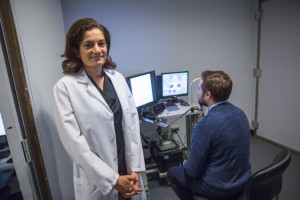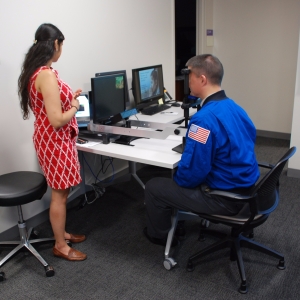Eye tracking detects high pressure inside the skull
Contact: Christine Hill 612.873.5719
Doctors Can Detect Pressure Increases Inside the Skull By Tracking Eye Movements During Watching of Music Videos

- Dr. Uzma Samadani
Eye movement tracking while watching a music video for 220 seconds can reveal whether there is increased pressure inside the skull. The technology works by measuring the function of the nerves that rotate the eyeball. “Doctors have known for more than 3000 years that high pressure inside the skull impairs the function of these delicate nerves, and that the first to be affected is usually the nerve that rotates the eye laterally” said neurosurgeon Dr. Uzma Samadani, the lead study investigator.
Participants in the National Space and Biomedical Research Institute (NSBRI) funded study were 23 patients in the neurosurgical intensive care unit who were awake but had brain problems such as bleeding, trauma, stroke or tumors requiring intracranial pressure monitoring with a drainage catheter. On 55 occasions the patients watched music videos and Disney film clips while an eye tracking camera measured vertical and horizontal eye movements for 220 seconds. There was a correlation between increased intracranial pressure and decreased function

- During a recent visit NASA astronaut Kjell Lindgren, MD (who received his medical training at HCMC), was given a demonstration of the eye-tracking technology.
of the nerves moving the eye as detected with eye tracking. Decreased lateral eye movements showed the strongest correlation with elevated intracranial pressure, consistent with what has long been known about nerve function. Individual patients had normal tracking at lower pressures and decreased eye movement at higher pressures regardless of whether the high or low pressure occurred first.
Dr. Samadani, who is the Rockswold Kaplan Endowed Chair for Brain Injury Research at Hennepin County Medical Center as well as an Associate Professor at the University of Minnesota Medical School, noted that concussion and elevated intracranial pressure impact many of the same eye tracking metrics, suggesting that similar pathways may be impaired.
Study results were presented at a joint NASA/NSBRI research group meeting and are now published in the Journal of Neurosurgery. The company Oculogica Inc has licensed exclusive world-wide rights for commercialization of the technology, for which a patent was issued earlier this month.
NSBRI funded the eye tracking research as a grant to the company Oculogica Inc through the SMARTCAP program which supports commercialization of technologies that will have utility both in space and on earth. Eye tracking for detection of elevated intracranial pressure could potentially benefit 7 million Americans with hydrocephalus as well as have utility for concussion and other types of brain injury. One potential indication for eye tracking would be identification of concussed subjects at high risk for second impact syndrome, which is thought to occur after, and further contribute to high intracranial pressure, which can be fatal.
NSBRI has a program investigating technologies for non-invasive monitoring of intracranial pressure which can potentially be elevated during space travel. Astronauts who experience reduced gravity for prolonged periods of time are at risk for developing headaches and visual problems. It is thought that without gravity, there is increased pooling of blood in the brain and elevated pressures inside the skull and eye structures. This risk for elevated intracranial pressure impacts NASA’s plan for prolonged space travel. Untreated elevated intracranial pressure can lead to cognitive difficulty and vision problems including blindness. On earth, doctors currently drill holes into the skull to place monitors to measure this pressure in patients with trauma, bleeding in the brain, or certain tumors. In space, such a measurement is not feasible, necessitating non-invasive measurement.
Dr. Samadani is a founder of the company Oculogica Inc., which is currently applying for FDA clearance for the eye tracking technology, called EyeBox. She disclosed that she, New York University, the Department of Veterans Affairs and Hennepin County Medical Center all had equity interests in the company.

